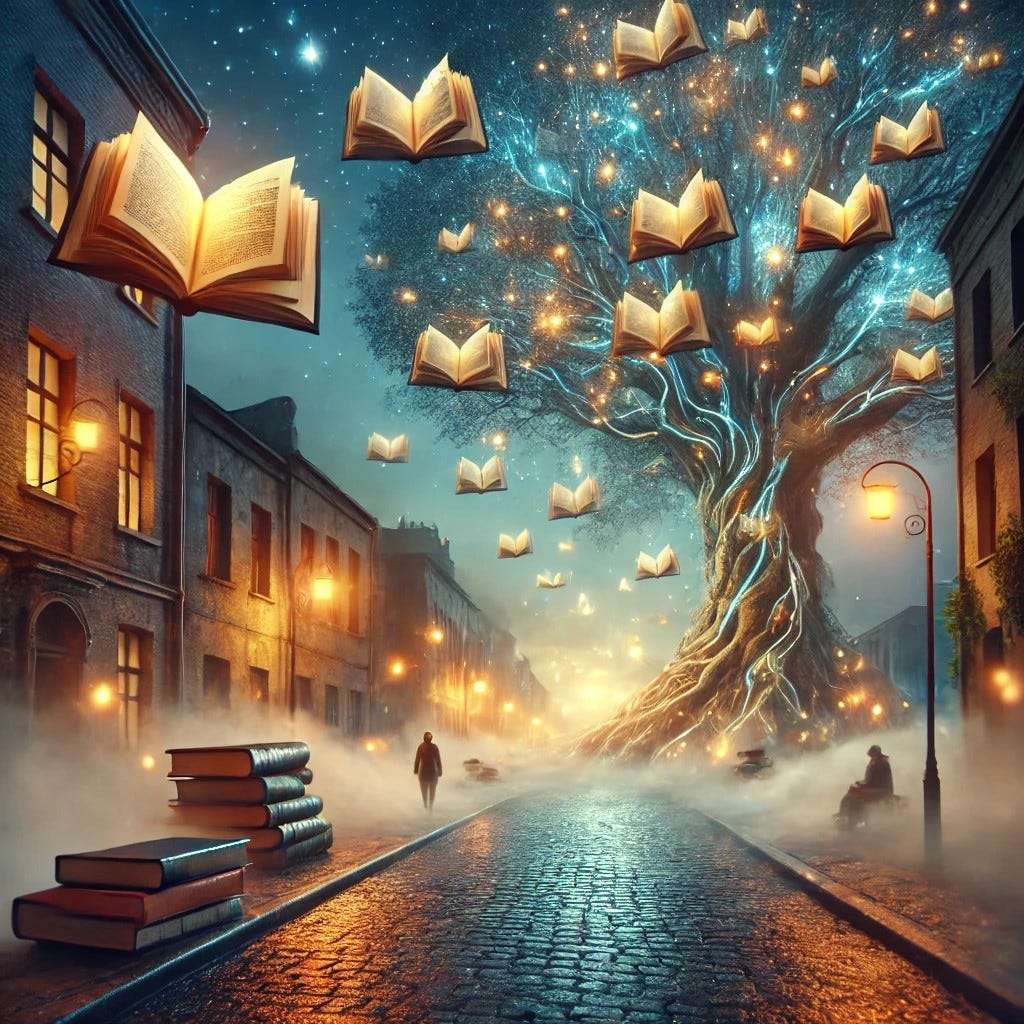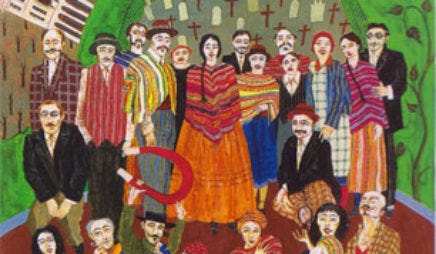Waking in a Dream
A Journey Through Magical Realism in Literature
Welcome to Beyond the Bookshelf, a community of readers and writers sharing unique perspectives on life and literature through thought-provoking essays, captivating interviews, and influential books as we explore the challenges of life's transformative journey.
Dear friends,
If you are the type of reader who prefers formulaic genre fiction, diving into the classics, or stories with narrative-driven plots, there is a decent chance you have never read any books in the genre of magical realism. If you happened to brave those waters, you may have wondered what you read. That was my experience when I first read One Hundred Years of Solitude by Gabriel Garcia Marquez. The story was so surreal that I couldn’t understand the ideas. I set it aside, frustrated and wondering how this mess of language could be so famous. It was many years before my literary palette could discern the intricacies of this genre without losing my way.
Magical realism, a genre that unfolds in the midst of everyday life, presents a unique reading experience. The setting is not fantastical, but realistic. The author does not create a new world; instead, they reveal the magic in the existing world by showing us that the line between fantasy and reality is blurred, allowing the magical and the mundane to intertwine. The author intentionally does not draw attention to the mystical elements because they are considered a normal and accepted part of the story. Temporal and spatial distortion exists in a manner that seems bizarre to the reader but ordinary to the characters. This unique literary movement frequently uses fantastical elements as a metaphor for internal conflict and moral quandary or to draw attention to social and political realities that would be dangerous to comment on directly. It is known for avoiding the typical narrative arc found in most novels, and this distinct lack of a clear beginning, middle, and end creates a reading experience that is both challenging and rewarding.
The German art critic Frank Roh first used the term “magischer realismus” or magic realism " in his book, Nach Expressionismus: Magischer Realismus (After Expressionism: Magic Realism). Roh used the term to describe a new style of painting that was finding popularity in Germany, emphasizing how everyday objects can appear strange and magical on closer observation. The term soon found its way into other art forms, with literature taking ownership of the concept. These ideas influenced the Cuban writer Alejo Carpenter during a visit to Paris, and he expounded on Roh’s ideas, mainly as they applied to Latin America, by coining the term “marvelous realism.”
Magical realism (a combination of magic and marvelous realism) was first used in 1955 when literary critic Angel Flores wrote an essay entitled Magical Realism in Spanish American Fiction. He theorized that the famed Argentine author Jorge Luis Borges was the first to write definitively in this new genre, particularly in his short-story collection, Historia Universal de la Infamia (A Universal History of Infamy). Interestingly, although the Latin American literary culture developed magical realism into the genre we now know, upon deeper reading, we find evidence of this writing style before Roh’s initial use of the term. The most famous of these examples is The Metamorphosis by Franz Kafka, published in 1915. Gabriel García Marquez, the esteemed Nobel Laureate I struggled to read in my youth, credited Kafka’s writing as a significant influence.
“The first line almost knocked me out of bed…When I read that line, I thought to myself, I didn’t know anyone was allowed to write things like that. If I had known, I would have started writing a long time ago.” - Gabriel Garcia Marquez
Magical realism has been influential in the literary world in many ways. It is closely related to metafiction because both involve narrative techniques that challenge conventional notions of reality and storytelling. Metafiction, in simple terms, is fiction about fiction. It often blurs the boundaries between what is real and what is fictional, and it questions the process of creating and consuming narratives, highlighting the artificiality of storytelling. Both approaches encourage readers to be critical of reality as presented by traditional narratives.
Most importantly, both genres explore how perception shapes reality. Magical realism allows fantastical elements to coexist with mundane reality, suggesting that reality is subjective and multifaceted. Metafiction does this by breaking the fourth wall or reflecting on its storytelling, implying that truth and fiction are intertwined and malleable. While magical realism and metafiction have distinct qualities, they both aim to challenge traditional storytelling conventions and broaden the reader's understanding of reality and fiction. By doing so, they invite readers to question and reconsider their preconceived notions about storytelling and reality, fostering a sense of enlightenment and open-mindedness.
Magical realism also played a significant role in political critique, particularly in contexts where traditional forms of expression are limited or censored. The genre has been a powerful tool for addressing complex political realities, especially in regions like Latin America, Africa, and post-colonial societies. Magical realism often critiques authoritarian regimes and oppressive systems by blending the surreal with the real, allowing writers to express dissent in less direct ways and, therefore, less likely to be censored. The fantastical elements create a layer of distance between the narrative and reality, providing a subtle yet powerful means of critique. This empowerment through engagement with political issues is a key aspect of the genre that readers can appreciate and be inspired by. For example, in García Márquez’s One Hundred Years of Solitude, the Buendía family’s history serves as a metaphor for Latin American history, indirectly critiquing cycles of violence, corruption, and political oppression.
Magical realism often elevates marginalized or Indigenous communities' experiences, beliefs, and worldviews, challenging dominant narratives. Treating the mystical or supernatural as everyday occurrences, these stories validate perspectives typically dismissed by rational or colonial worldviews. This serves as a critique of colonialism and cultural imperialism, asserting the validity of alternative ways of knowing and living. In conjunction with this, many post-colonial writers use magical realism to depict the absurdities, contradictions, and traumas left in the wake of colonial rule. By infusing the narrative with elements that defy logic or natural laws, magical realism reveals the deep psychological scars of colonization and the ongoing struggles with identity, cultural erasure, and political instability. For instance, in works like Salman Rushdie’s Midnight’s Children, the magical elements are intertwined with historical events, providing a layered commentary on the tumultuous transition from colonialism to independence.
Magical realism can unveil hidden realities in societies where truth is manipulated or suppressed. The genre’s blending of the fantastic with the real allows authors to expose truths that might otherwise be censored or ignored. Through allegory and symbolism, magical realist works can portray harsh social and political conditions—such as violence, poverty, and injustice—in a profoundly resonating way without being overtly confrontational. Magical realism often employs irony and satire to mock the absurdities of political systems. By depicting the fantastical as expected and the real as absurd, these stories highlight the irrationality and corruption within political structures. The exaggerated, surreal elements can serve as metaphors for the excesses and failures of those in power.
If you are interested in exploring the genre of magical realism, there is an abundance of excellent writing to choose from. While Latin American literature is the genre's foundation, it has spread worldwide and is available widely in many languages. Some of the best-known authors in the genre are listed below for you to explore.
Gabriel Garcia Marquez
Jorge Luis Borges
Isabel Allende
Laura Esquivel
Salman Rushdie
Haruki Murakami
Neil Gaiman
Franz Kafka
Alejo Carpentier
Italo Calvino
Mikhail Bulgakov
Toni Morrison (although she rejected the term, her novel Beloved is a classic example of this genre)
My friend and fellow writer, , wrote an article on Magical Realism, which you may also enjoy.
Until next time…








Although I'm not THE writer/reader that you are, I am learning so much simply by reading your essays. I also enjoy the comments in which others respond. I almost feel like I'm taking a class, because I'm learning so much. Thanks for sharing.
I think there’s a lot of writing from the African continent that blends and runs with magic realism too. I really enjoyed Chicozie Obiome’s ‘Orchestra of Minorities’ which had hints of the genre about it. Loved Kafka’s two seminal books, Bulgakov too. Enjoyed ‘100 Years…’ but think I started and then didn’t finish ‘Love in the Time of Cholera’, and have never quite been sold by Murakami’s and Rushdie’s books, though have tried a few times to be so!